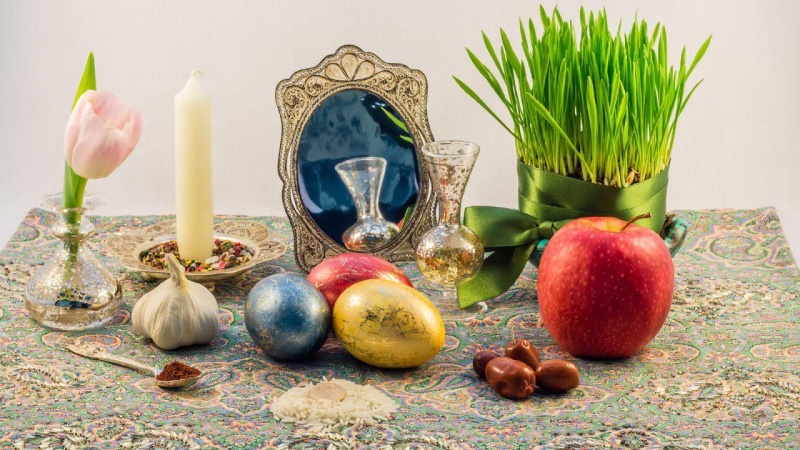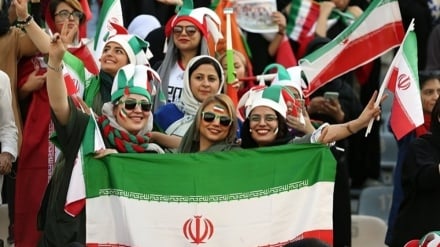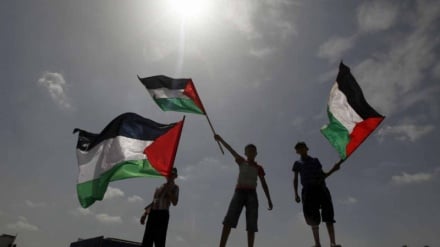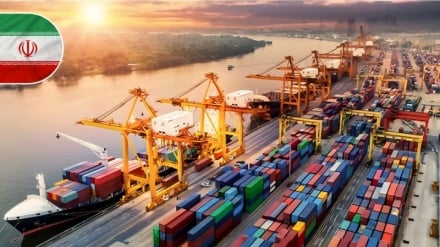Haftseen Tablecloth Tablecloth
Spreading of Sofreh Haftseen (Haftseen Tablecloth) is one of the most famous customs of Nowruz ceremonies in Iran. This tablecloth is a symbol of freshness and happiness and is a means for gathering of family members at the spiritual moments of the New Year.
On the first day of spring, as the year changes to the new one, family members sit around the tablecloth with clean and new clothes and start the coming of New Year with joy and love. Spreading of Haftseen Tablecloth in Nowruz is a symbolic act which besides joy of heart, contains moral and educational messages.
In the ancient Iran, every feast was accompanied with spreading of a tablecloth which comprised of a variety of edibles and beautiful things. The tablecloth spread for Nowruz is called Haftseen as it is made up of seven items whose names begin with Farsi letter "Seen". Haftseen tablecloth used to be spread on a spot above the ground a few hours before the turn of the year. Haftseen comprises of these items:
- Sabzeh (wheat greens and sprouts or lentil sprouts, vetch sprouts and so on): This symbolizes regeneration, liveliness and greenery. It is the sign of man's link with the nature.
- Samanoo (a sweet paste made up of wheat sprouts): It symbolizes productivity of plants.
- Seeb (apple): It symbolizes health and beauty.
- Senjed (Oleaster or Russian olive): It symbolizes affection, love and generation.
- Somaq (Sumac): It symbolizes patience and restoration as it is the color of sunrise.
- Seer (Garlic): It symbolizes the healing of ailments and sufferings as it is a good antiseptic.
- Serkeh (Vinegar): It symbolizes patience and perseverance as it takes a long time to make vinegar.
It should be noted that sometimes Sekkeh (coin) is considered as one of the items of Haftseen tablecloth instead of Seeb (apple). Moreover, Iranians put other things on this tablecloth such as painted eggs, mirror, a bowl of water with fish in it, a candle and hyacinth flowers. Besides all these items, a copy of the noble Qur'an always adorns Haftseen tablecloth.
A simple look at the items of Haftseen tablecloth reveals that most of the edibles are rich in minerals and vitamins. By spreading Haftseen tablecloth, Iranians have transferred the message of healthy living to the contemporary generation. A review of the properties of these items can confirm this claim.
Apple is rich in vitamins A, B, and C. It also contains fiber, calcium, phosphorus, potassium, sodium and malic acid. The most important substance of apple is potassium which is famous as "element of rejuvenation" since it softens the walls of the arteries and decreases blood pressure. Apple is rich in anti-oxidants and a type of fiber called pectin. An average-sized apple contains 4 grams of fiber. Improvement of digestion function, reduction of cholesterol, reduction of cancer risk, longevity and prevention of hair loss are among other properties of apple. Since apple has no sugar it is recommended for people suffering from diabetes.
Oleaster (Russian olive), too, has many useful properties. This fruit is replete with vitamins C and E and carotene pigment all of which have anti-oxidant properties. Flavonoid compounds and fatty acids like linoleic acid give it an anti-inflammatory property. That's why consumption of oleaster is recommended for those who suffer from muscular and joint problems. Research shows that consumption of the fruit and powder of its seed is useful for treatment of acute and chronic inflammation. The high amount of calcium in oleaster prevents from softness of bone. It is also good for curing of dysentery resulting from amoeba.
Sumac is another constituent of Haftseen tablecloth. It is a good appetizer and dressing for foods. It is a cleaner of stomach and heals diarrhea. It is useful for curing of diabetes, rheumatism and gout, too. Sumac is a blood purifier and removes residual substances like uric acid from blood. That's why it is often consumed with kebab in Iran and other regions.
Garlic is often known as a dressing but it is a medicinal plant. This constituent of Haftseen tablecloth is used for prevention and treatment of different diseases. Garlic is rich in folic acid, vitamin C, calcium, iron, magnesium and potassium. It also has lesser amount of zinc, vitamins B1, B2 and B3. This plant is very useful for curing heart diseases and high blood pressure or arteriosclerosis. It has been proved that garlic is effective in prevention of various cancers of digestion system and prostatitis. Some scientists believe that garlic can prevent food poisoning because it has anti-fungal and anti-bacterial properties.
Vinegar is another constituent of Haftseen tablecloth. It has a lot of medicinal properties. This miraculous substance helps digest heavy foods and accelerates entrance of food factors into the cells. It has been a palatable dressing since old times due to its sour taste. Vinegar destroys blood and bilious infections and prevents cancer to some extent. It is useful for controlling weight and curing of some infections. Evidence shows that vinegar, due to absorption of calcium, helps bone-building in body. It has some anti-bacterial and anti-fungal properties, too.
The last constituent of Haftseen tablecloth is Samanoo which is made of fresh wheat sprouts. Although no sugar is added to it, it tastes sweet and delicious. Samanoo has vitamins A, E, K and is rich in vitamins, B1, B2, B3, B5, B8 and B12. There are good amounts of calcium, potassium, phosphorus, selenium and iron in Samanoo, too. These substances make Samanoo a complete nutritious food which is good for skin, hair, nervous system, memory, blood circulation, bones, teeth, sight and many parts of the body. It is specially recommended for athletes, children, pregnant and breastfeeding mothers, people suffering from anemia, liver problems, osteoporosis and MS. Samanoo is a good choice for securing of calories, preservation of youth, health and countering depression.
RM/MG



